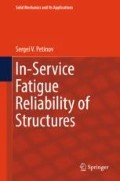Abstract
The chapter is focused on the brief discussion of fatigue crack propagation evaluation using the technique of the linear elastic fracture mechanics when the residual fatigue life of an affected structural component has to be estimated. The methods of evaluation of the stress intensity factors in various structural details with cracks are briefly characterized. The standard methods of testing structural materials aimed at evaluation of the crack growth characteristics are discussed. The Griffith–Irvin theory of instable fracture and standard experimental procedure of evaluation of the fracture toughness of materials is presented.
Access this chapter
Tax calculation will be finalised at checkout
Purchases are for personal use only
References
Christian GA (2010) Bridge failures—lessons learned. Bridge Engineering Course. University at Buffalo, March 29, 2010
Veritas DN (2010) Fatigue assessment of offshore steel structures. Recommended Practice (DNV-RP-C203). Hovik, Norway
Miller KJ (1993) Materials science perspective of metal fatigue resistance. Mater Sci Technol 9:453–462
Kuhn et al. (2008) Assessment of existing steel structures: recommendations for estimation of remaining fatigue life. JRC-ECCS Report EUR 23252 EN: 89. ISSN 1018-5593
Paris PC, Erdogan F (1963) A critical review of crack propagation laws. J Basic Eng ASME 85:528
Broek D (1984) Elementary engineering fracture mechanics. 3rd edn, Martinus Nijhoff Publishing, The Hague, p 469
Petinov SV (2003) Fatigue analysis of ship structures. Backbone Publishing Co., Fair Lawn, NJ, USA
Westergaard HM (1939) Bearing pressures and cracks. J Appl Mech (6):A-49–A-53
Irvin GR (1957) Analysis of stresses and strains near the end of a crack traversing a plate. Trans ASME J Appl Mech 24:361–364
Aamodt B (1974) Application of the finite element to fracture mechanics. Department of Structural Mechanics, NTH, Trondheim
Barsoum RS (1974) Singular finite elements are unnecessary. Int J Fract 10:603–605
Sedov LI (1962) A course in continuum mechanics. Volters-Noordhoff, Groningen
Tada H, Paris P, Irwin GR (1973) The stress analysis of cracks handbook. Del Research Corp, Hellertown, Penn
Murakami Y (ed) (1987) Stress intensity factors handbook. Pergamon Press
Rice JR (1967) The mechanics of crack tip deformation and extension by fatigue. Fatigue crack propagation. ASTM STP 415:247–309
Schijve J (1967) Significance of fatigue cracks in micro-range and macro-range. ASTM-STP 415:415–459
Elber W (1971) The significance of fatigue crack closure. damage and tolerance in aircraft structures. ASTM STP 485:230–242
Elber W (1976) Equivalent constant-amplitude concept for crack growth under spectrum loading. ASTM STP 595:236–250
Griffith AA (1921) The phenomena of rupture and flow in solids. Phil Trans R Soc Lond A221:163–198
Brown WF, Srawley JE (1965) Fracture toughness testing methods. ASTM STP 381:133–145
Troshchenko VT, Sosnovsky LA (1987) Soprotivlenie ustalosti metallov i splavov. Spravochnik (Fatigue resistance of metals and alloys. A handbook). Naukova Dumka, Kiev
Author information
Authors and Affiliations
Rights and permissions
Copyright information
© 2018 Springer International Publishing AG, part of Springer Nature
About this chapter
Cite this chapter
Petinov, S.V. (2018). Residual Life Assessment When Fatigue Cracks Are Detected in Structure. In: In-Service Fatigue Reliability of Structures. Solid Mechanics and Its Applications, vol 251. Springer, Cham. https://doi.org/10.1007/978-3-319-89318-1_8
Download citation
DOI: https://doi.org/10.1007/978-3-319-89318-1_8
Published:
Publisher Name: Springer, Cham
Print ISBN: 978-3-319-89317-4
Online ISBN: 978-3-319-89318-1
eBook Packages: EngineeringEngineering (R0)

